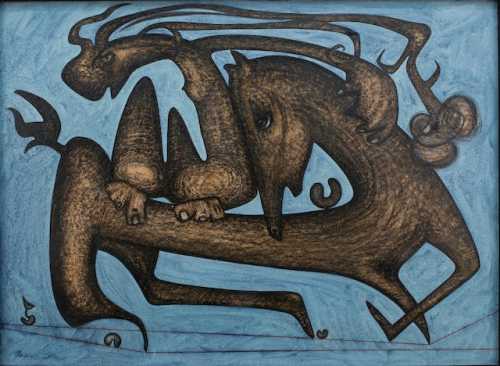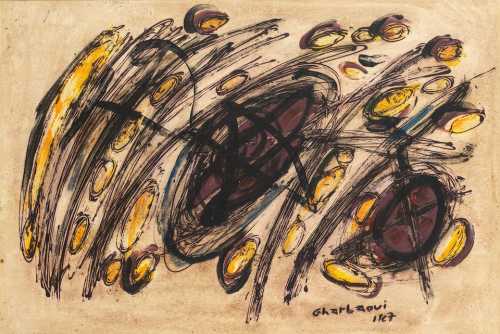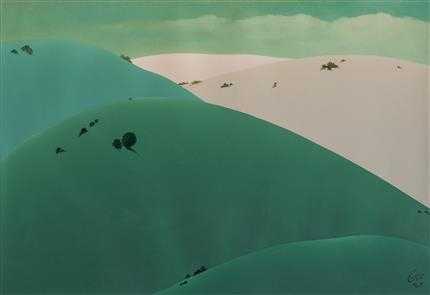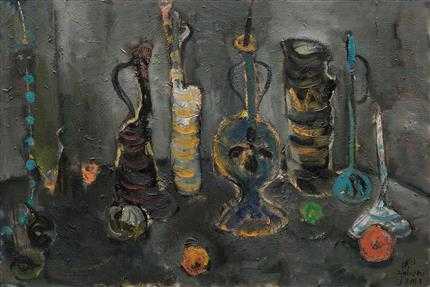- Abstract Rhythms 1967
- Oil on Cardboard
- Painting
- 76 * 52 cm
- Signed "Gharbaoui" and dated "1967" (lower left) executed in 1967
Framed
Estimation
£6,000
8,344 USD
-
£10,000
13,906 USD
Realized Price
£7,650
10,638 USD
4.375%
Artwork Description
Jilali Gharbaoui was a leading artist of the modernist movement in Morocco. Born in 1930 in the Sidi Kacem region of Morocco, Gharbaoui began studying fine art while in secondary school in Fes at the Academie des Arts. With the support of novelist Ahmed Sefrioui, the director of fine arts in Rabat, Gharbaoui was able to continue his training at the École des Beaux Art in Paris, later spending a year studying in Rome as well. Throughout his life, the artist suffered from mental illness and in 1971 his body was found on a public bench in the Champs de Mars in Paris; it was repatriated to Morocco and the artist was buried in Fes. Living in poverty, depressed, having spent several stays in psychiatric hospitals, he embodied the archetype of the tormented artist. Despite his short life, Gharbaoui's life has been celebrated worldwide for his artistic career and in 1993 he had a retrospective at the Institut du Monde Arabe in Paris.
Eager to break away from the traditional Moroccan geometric iconography, Gharbaoui's practice focuses on the gesture of painting itself and the materiality of the paint. He had an unconventional ways of painting and he sought a new form of self-expression and personal freedom in his work. He is known for his striking colours and was heavily influenced by his motherland, particularity the land and architecture. His paintings deliberately focus on the hand of the artist and often build up texture through thick layers of paint, showcasing both the interplay of colours and lines as well as the materiality of the paint itself.
Eager to break away from the traditional Moroccan geometric iconography, Gharbaoui's practice focuses on the gesture of painting itself and the materiality of the paint. He had an unconventional ways of painting and he sought a new form of self-expression and personal freedom in his work. He is known for his striking colours and was heavily influenced by his motherland, particularity the land and architecture. His paintings deliberately focus on the hand of the artist and often build up texture through thick layers of paint, showcasing both the interplay of colours and lines as well as the materiality of the paint itself.
More lots by Jilali Gharbaoui

Abstract
Estimation
£800
1,067 USD
-
£1,200
1,600 USD
Sale Date
Rosebery's Auction
-
24 October 2025

Abstract
Estimation
£1,200
1,600 USD
-
£1,500
2,000 USD
Sale Date
Rosebery's Auction
-
24 October 2025

Abstract
Estimation
£800
1,067 USD
-
£1,200
1,600 USD
Sale Date
Rosebery's Auction
-
24 October 2025
Realized Price
10,638 USD
Min Estimate
8,344 USD
Max Estimate
13,906 USD
Average Artwork Worth
-4.375%
Average Growth of Artwork Worth
Sales Performance Against Estimates
Similar Artworks

Odorless Black Flower
Estimation
£5,000
7,042 USD
-
£8,000
11,268 USD
Realized Price
£6,375
8,979 USD
1.923%
Sell at
Sale Date
Bonhams
-
9 March 2021


